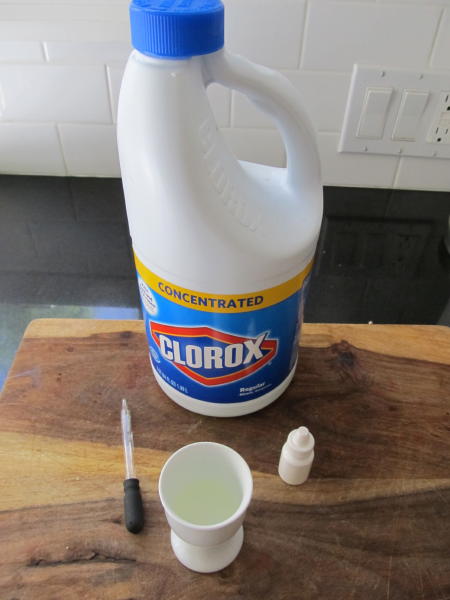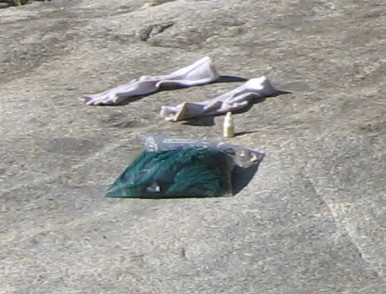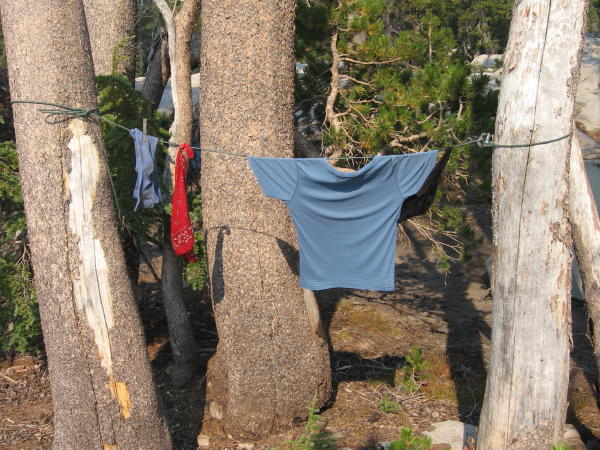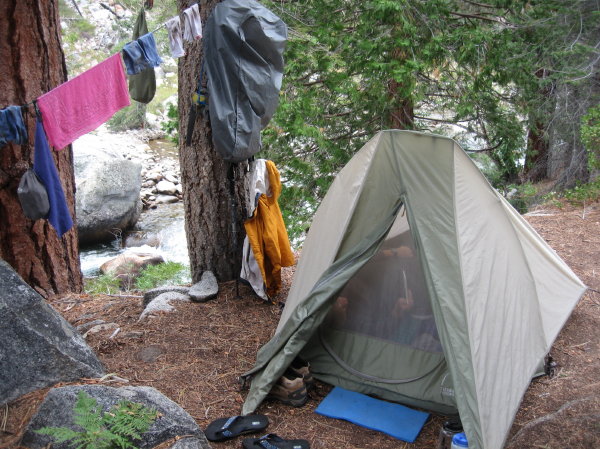A few drops of bleach and a zip-top bag full of water is all you need to keep your clothes clean while backpacking. I was skeptical when I first read about it. I tried it and found that my clothes smelled fresh and clean, more so than when I used biodegradable camp soap. Biodegradable soap requires soil to biodegrade so it must be used well away from water sources (200 feet). Biodegradable soap isn’t as environmentally friendly as one might think, so I try to limit my use.

I’ve been trying to lighten my load on the trail. While I technically haven’t achieved ultralight status, I have managed to get my pack weight down to a comfortable weight. For me, this is a base weight of about 16 pounds without food or water. There were a number of strategies that got me here, but one method was to reduce the amount of clothing to the bare essentials. I can’t stand being dirty and smelly, so I researched the laundry angle. I tried to balance efficiency (most days I’m pretty tired at the end of the day and don’t want to spend a lot of time wrestling with laundry), effectiveness (laundry should be clean and odor-free), eco-sensitivity (not contaminating the environment), and weight (not adding much weight to my pack) to achieve the laundry goal. This ruled out collapsible buckets, washing directly in streams and counting on soap to do the trick.
With the system I follow, I’m able to go indefinitely with one short-sleeved hiking shirt, one long sleeved sleep shirt, two pairs of underwear, two or three pairs of socks, one pair of shorts and one pair of long pants, all made of synthetic quick dry material. I know others can go with less but this is what works for me. I learned about this from various backpackers online so I can’t take full credit.

Supplies
The basic supplies are not hard to assemble:
- A small dropper bottle filled with bleach. The tiny bottles that eye drops come in work well, prominently labeled “bleach.”
- Zip-top bag. I’ve tried regular gallon-size freezer bags but in the Sierra, where sharp points of granite are everywhere, I found that after a few uses they sprouted tiny fountains. They were still usable, but soaking time decreased significantly. Now I use the thicker and sturdier aLokSak bags, which hold up much better. Update: I found gusseted 4-mil zip-top bags that stand up on their own, which is handy (JMK Zipper Seal Stand Up bags–no longer available).
- Biodegradable camp soap (optional and not necessary for every wash)
- Thin plastic twine, clothespin, or rubber band (optional).

Procedure
The procedure is as follows:
- At a stream or lake, open the zip-top bag and scoop water into it, filling it about ½ way.
- Add 3 drops of bleach, close the top and invert the bag a couple of times to make sure the bleach is dispersed in the water. On a daily basis I use only bleach, but every few days I might add a drop or two of detergent.
- Carefully open the bag of water, stuff the dirty clothes in and seal the bag closed. Invert the bag a couple of times and squeeze the clothes to make sure they get saturated.
- Lay the bag somewhere where it won’t get punctured, on grass, soft ground or a cloth.
- Leave it for 15 minutes or so while you do other camp chores. I usually use the time to clean myself, since I’m positioned near a water source anyway.
- After the clothes have soaked, take the bag at least 200 feet away from the water source, open the bag, scrub the clothes a couple of times and dump the water out.
- Go back to the water source, add more water to the bag and close it. Shake and squeeze to rinse, then dump the rinse-water away from the water source. Repeat if necessary. This involves a little back and forth but is necessary to protect the stream or lake.
- After rinsing, wring the clothes as dry as you can. If you have a camp towel and won’t need it anymore that day, wrap it around a shirt or whatever you most want to dry and wring it out more. The towel will absorb some of the water from the laundry. If the towel is still wet the next day, hang it off of your pack to dry.

- To dry, sometimes I just lay my clothes on a rock or tree branch in the sun. On cloudy or windy days, when the sun isn’t as strong or my clothes go flying into the dirt, I’ve found that hanging on a line of plastic string is beneficial. I tie one end to a tree using a slip knot, then weave the string through my t-shirt and underwear and anything else that has two openings, then tie the other end to another tree—this keeps clothing from blowing away. I sometimes tie a loop into one or both ends of the line and use a small carabiner to clip the end to another part of the line around a tree–this is faster than tying a slip knot. I would never have brought a clothespin, but I found a weathered, wooden clothespin at a backcountry campsite one time. I hung onto it, finding it handy to secure small items such as socks. My husband and hiking partner, Steve, usually carries a length of shock cord in case a tent pole fails. If I’ve gone overboard on the laundry (usually a “zero” day, a rest day with zero mileage) we string a longer clothesline. Afternoon breezes usually dry everything quickly in the low humidity air of the high Sierra. Occasionally a few items will still be slightly damp the next day. I find that shirts and pants can easily be “walked dry” and stubborn socks can be affixed to the outside of my pack to continue drying in the sun as I hike. Tilley socks really do dry overnight.

- To dry socks, wrap a rubber band around the top of a pair of socks. If you have a small carabiner, it can be hooked onto the rubber band to hang on the line. Otherwise, the socks can be draped over the line or a small branch.
You might think that bleach is too harsh for the clothes but I haven’t noticed any adverse effects, maybe because it’s such a low concentration. I followed some JMT forum discussions on the appropriateness of using bleach in the backcountry and the consensus seemed to be that bleach is probably preferable to detergent and if deposited in an open spot it would degrade in a fairly short period of time.
Wool
I’ve received a few questions about wool since merino wool is so popular now. Most of my backpacking clothing is synthetic so I haven’t used bleach on wool. However, the Clorox website states that bleach should not be used on wool. I recommend a few drops of biodegradeable soap for wool.
The bottom line
A few drops of bleach in a sturdy zip-top bag goes a long way toward maintaining trail hygiene. Clothes smell wonderfully fresh and clean. On occasion, adding a few drops of biodegradable soap may add additional cleansing benefits but is generally optional.
All photos by Inga Aksamit

 Previous Post
Previous Post

David Terrie says:
Hi Inga,
Thanks for being so generous with your knowledge. Would a small light-weight dry bag, say 4 liters, work as well? Does the bag need to be transparent for the sun to do its job? I have one I use to scoop water with and transfer into my Evernew/Sawyer mini combo for water purifying. I have a bad knee, so kneeling or crouching to get water into the Evernew bag directly is difficult. I also use it to just bring extra water back to campsite.
Inga says:
Yes, a dry bag would work fine. However, I don’t know what effect bleach might have on the dry bag. If you’re using biodegradeable soap away from the water source, that would be ok. A gallon zip top bag works for small items. Opsak makes some larger bags. There’s the Srubba bag but it’s pretty heavy for bacpacking. The bleach or soap is the operative agent here so transparency isn’t important.
Weasel says:
I wonder about the color bleaching effects of bleach on clothes. Diluted that much, have you noticed any /additional/ fading in your hiking clothes (aside from general sun fading).
Inga says:
I don’t find that the dilute bleach solution bleaches the color out of my synthetic clothing. I’ve been using this method for five years now.